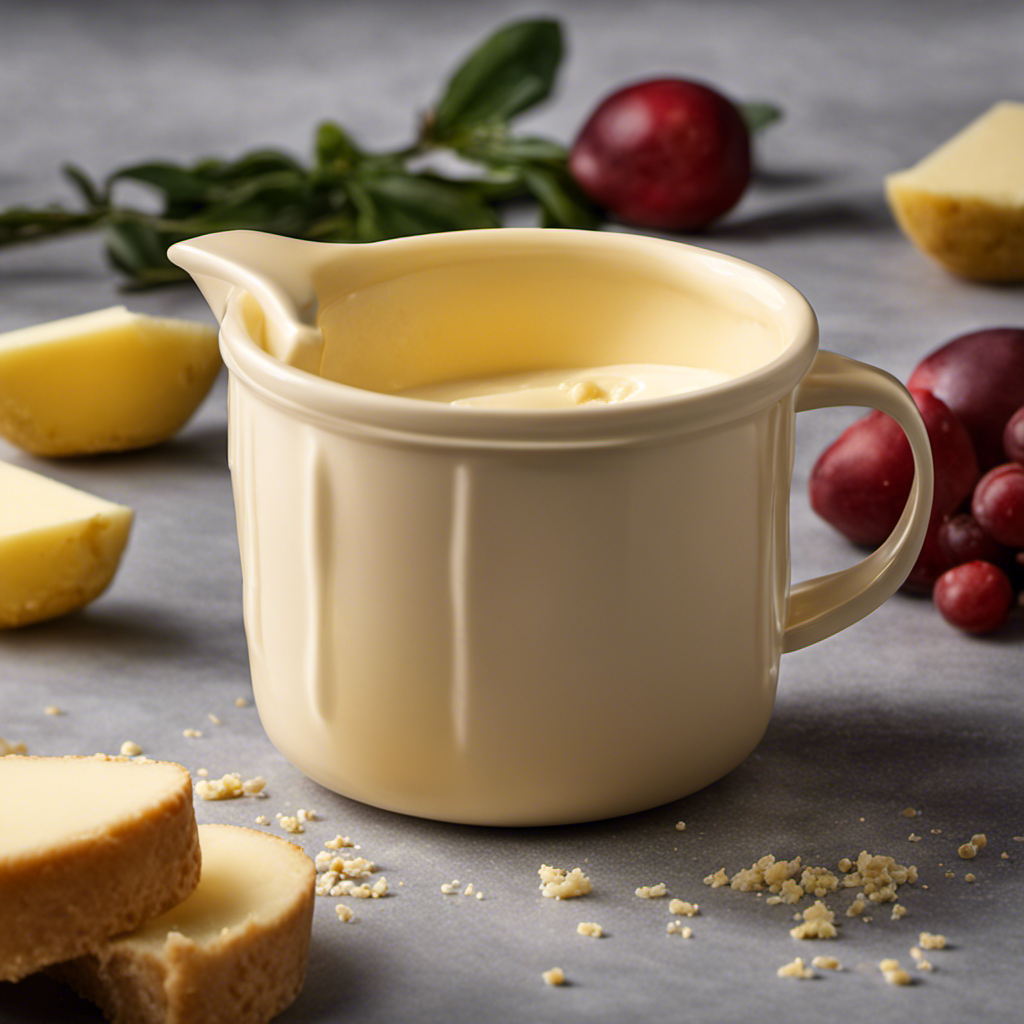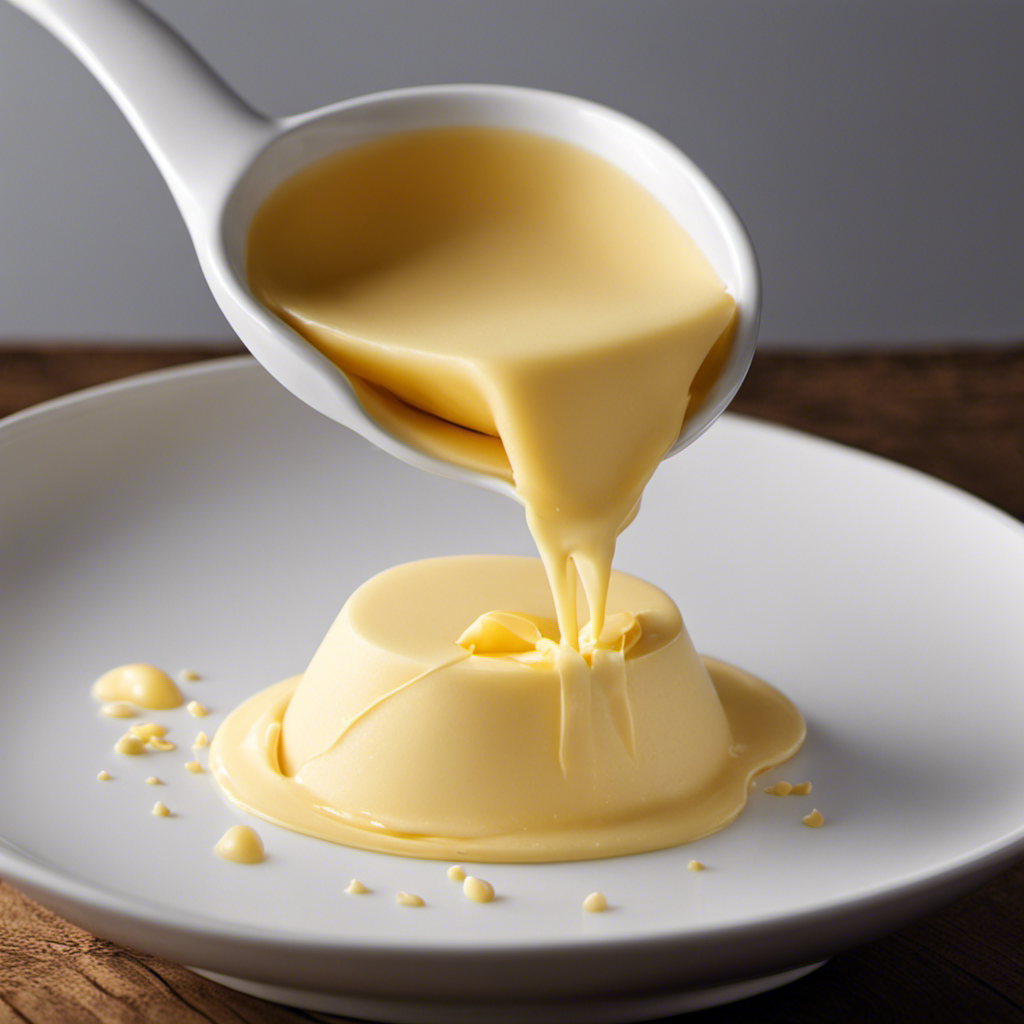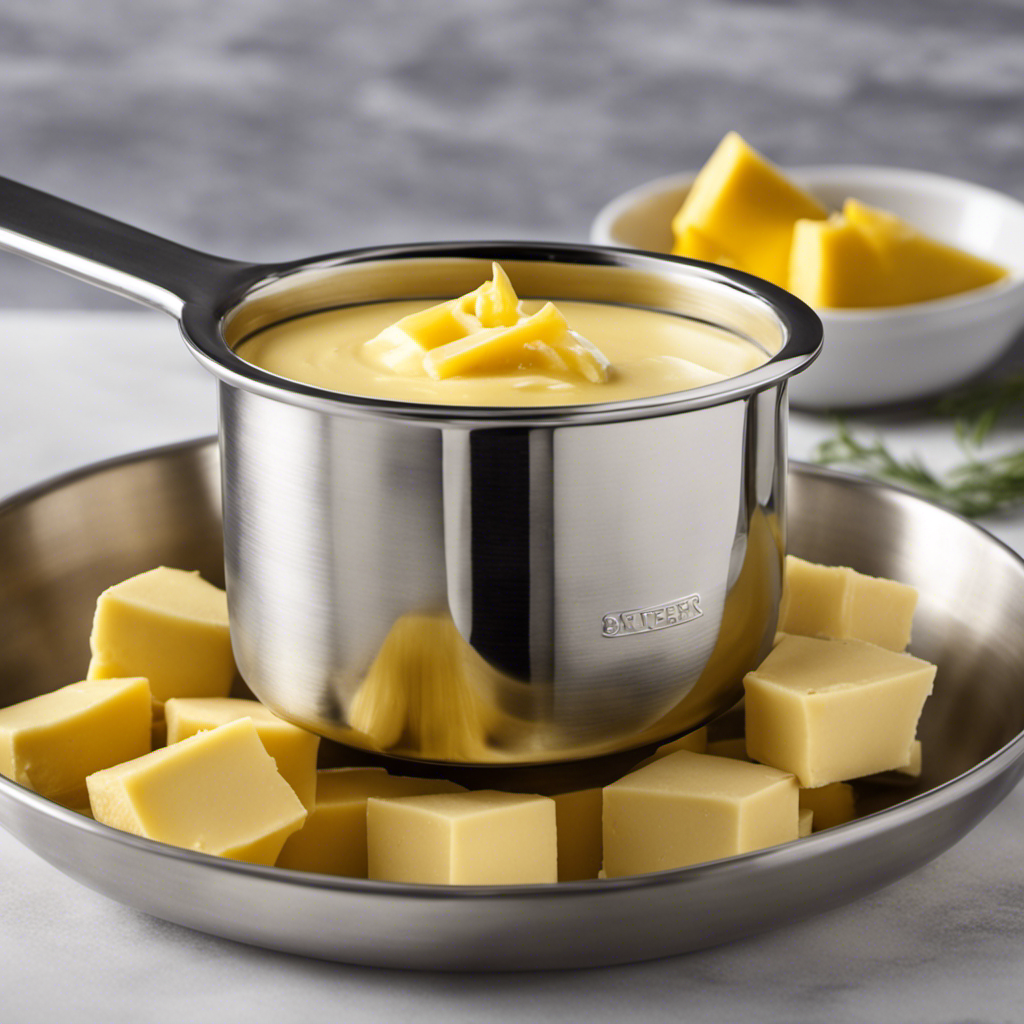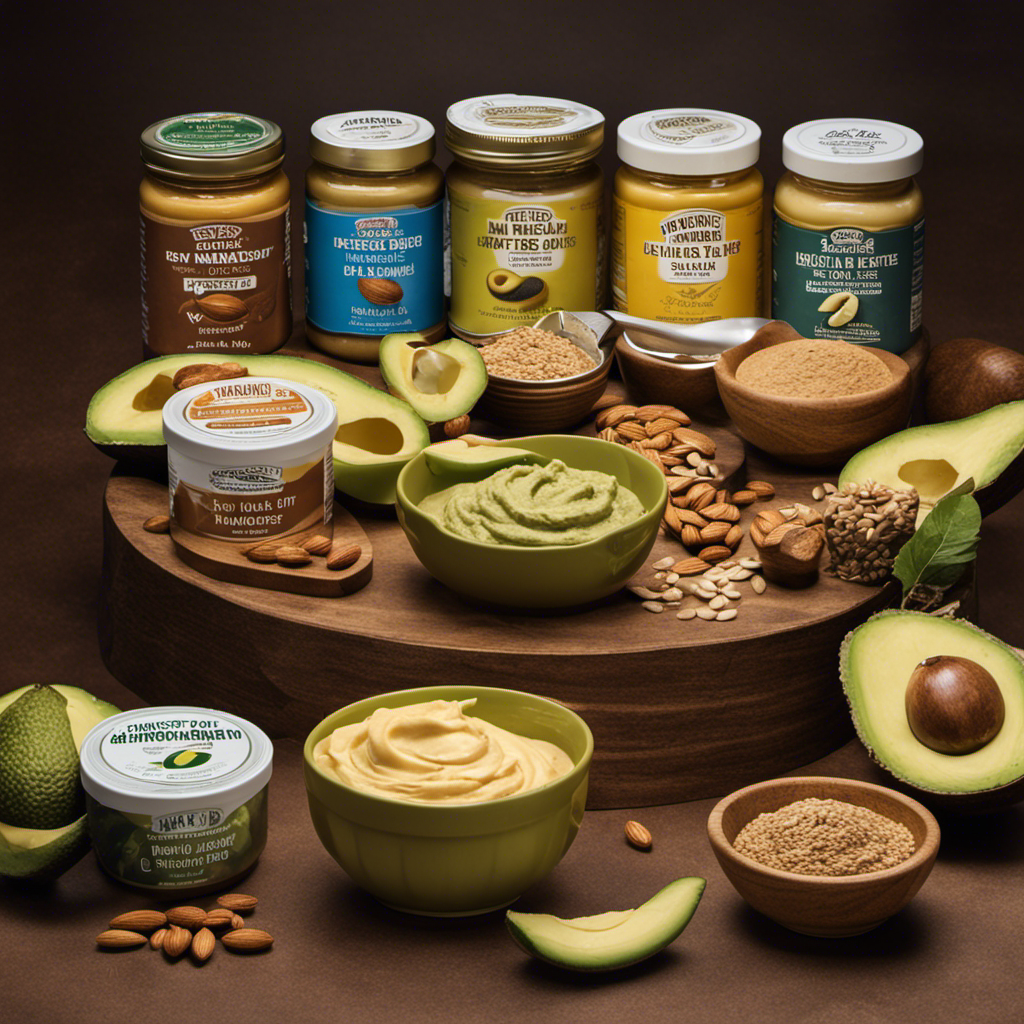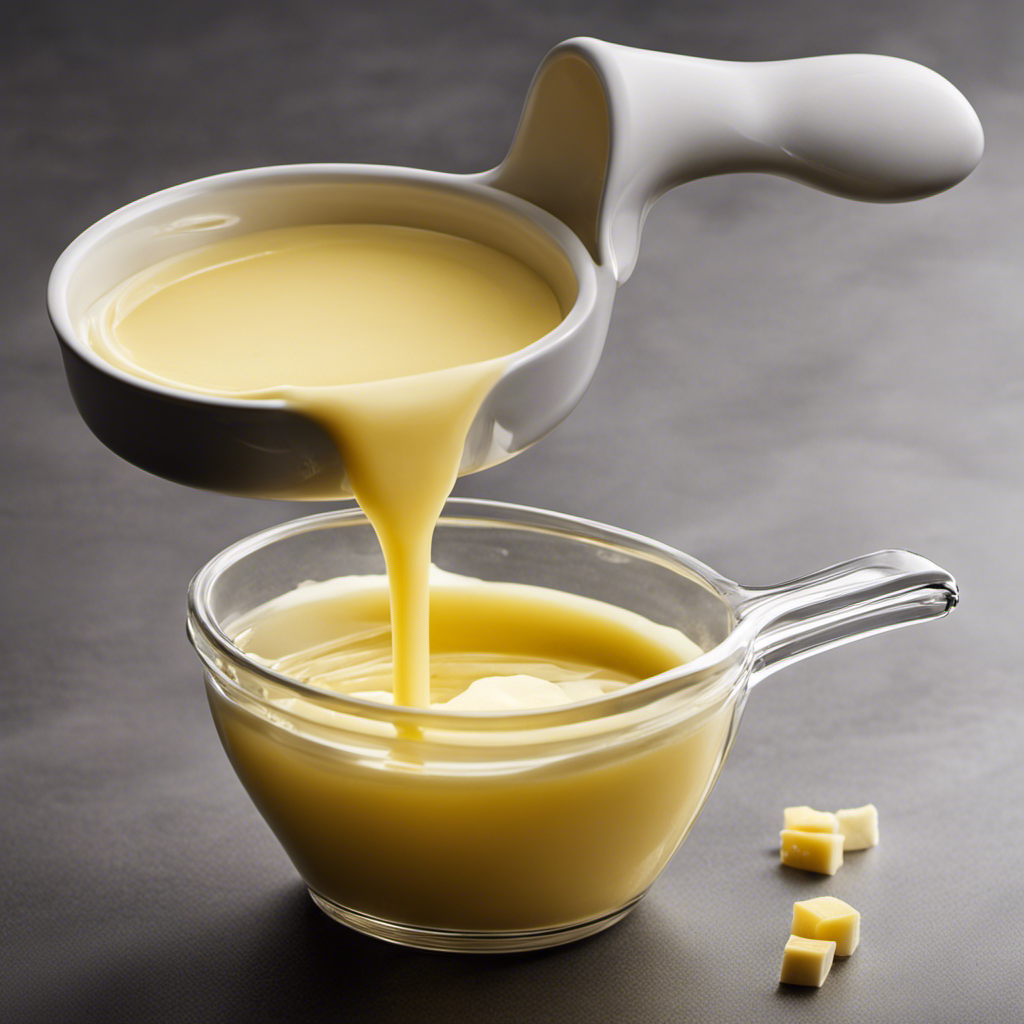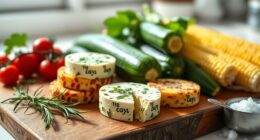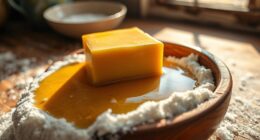As an enthusiastic baker, I have always held the conviction that precision is crucial for crafting the ideal dessert. In the realm of ingredient measurement, achieving exactness is absolutely essential.
So, when faced with the question of how many grams are in 1/2 cup of butter, I delved into the world of conversions and measurements. In this article, I’ll guide you through the process of converting cups to grams for butter, ensuring that your baking endeavors are nothing short of perfection.
Key Takeaways
- 1 stick of butter is equal to 1/2 cup or 113 grams.
- Butter substitutes may have different densities or water content compared to butter, so adjust measurements accordingly when using them.
- Weighing ingredients with a scale is more precise than using volume measurements.
- Accuracy is crucial in baking for consistent and reliable recipes, and inaccurate measurements can lead to texture issues, uneven baking, and recipe failure.
Understanding Butter Measurements
There’s a lot to learn about butter measurements. When it comes to measuring techniques, precision is key.
To accurately measure butter, it is important to understand the different forms it can come in. Butter is typically sold in sticks or in tubs.
One stick of butter is equal to 1/2 cup or 113 grams. This measurement is important to know when following recipes that require specific amounts of butter.
Additionally, for those who are looking for butter substitutes, it is useful to know that there are alternatives available such as margarine or vegetable spreads. These substitutes can be used in baking or cooking, but it is important to adjust the measurements accordingly, as they may have different densities or water content compared to butter.
Converting Cups to Grams for Butter
To convert 1/2 cup of butter into grams, all you need to do is multiply the cup measurement by the appropriate conversion factor. In this case, the conversion factor for butter is 227 grams per cup. So, to find the grams in 1/2 cup of butter, you would multiply 1/2 by 227, which equals 113.5 grams.
It’s important to understand conversion rates when working with different measurements in recipes. Here are some tips for accurate measurements:
- Use a scale: Weighing ingredients is more precise than using volume measurements.
- Use a liquid measuring cup for liquids and a dry measuring cup for dry ingredients.
- Level off measuring cups and spoons for accuracy.
- Convert between units using reliable conversion factors.
The Importance of Accuracy in Baking
When it comes to baking, accuracy is key. Using precise measuring tools ensures that ingredients are measured accurately, resulting in consistent and reliable recipes.
Inaccurate measurements can have a significant impact on the final outcome of baked goods, leading to undesirable effects such as texture issues, uneven baking, and even complete recipe failure.
Measuring Tools for Accuracy
Grab your measuring tools and make sure they’re accurate for getting the correct amount of butter in grams for 1/2 cup. When it comes to measuring butter alternatives, precision is key. Using digital scales can provide accurate measurements, ensuring your recipes turn out just right.
Here are some important factors to consider when using measuring tools for accuracy:
- Digital Scales: Invest in a reliable digital scale that measures in grams. This will give you precise measurements for your butter.
- Tare Function: Make use of the tare function on your digital scale. This allows you to zero out the weight of your measuring container, ensuring you only measure the butter.
- Consistency: Ensure that all your measurements are consistent. Use the same measuring tools for all your ingredients to maintain accuracy.
- Leveling: When measuring butter, use a straight-edged spatula or knife to level off the top of the butter, ensuring an accurate measurement.
Consistency in Ingredient Quantities
Using the same measuring tools for all your ingredients ensures consistent quantities in your recipes. Understanding ingredient conversions and the importance of precision in baking is crucial for achieving delicious results.
When it comes to baking, even the slightest variation in ingredient quantities can greatly affect the final outcome. That’s why it’s essential to use accurate measurements and follow the recipe instructions carefully.
Whether it’s measuring flour, sugar, butter, or any other ingredient, using a digital scale or measuring cups and spoons can help you achieve the desired consistency. Precision in baking is not only about following the recipe, but also about understanding how different ingredients interact and affect the final product.
Effects of Inaccurate Measurements
Incorrect measurements can lead to disappointing and inconsistent results in your baking. As a home baker, I’ve learned the hard way that accuracy is key when it comes to measuring ingredients.
Here are some effects of inaccurate measurements that I’ve experienced, along with some tips for achieving precise measurements:
- Dry or dense baked goods: Using too much flour or not enough liquid can result in dry and dense baked goods.
- Flat or sunken cakes: Incorrect measurements of leavening agents like baking powder or baking soda can cause cakes to not rise properly.
- Overly sweet or salty dishes: Adding too much or too little sugar or salt can throw off the balance of flavors in your dish.
- Inconsistent results: Inaccurate measurements can lead to inconsistent results, making it difficult to replicate your favorite recipes.
To ensure precise measurements, I recommend using a kitchen scale for dry ingredients and measuring liquids at eye level in a liquid measuring cup. It’s also important to spoon and level dry ingredients, rather than scooping them directly from the container.
Following these tips will help you achieve consistent and delicious results in your baking endeavors.
The Standard Conversion for Butter
In this discussion, I will explore the topic of Butter Measurement Equivalents and Converting Cups to Grams.
Understanding the standard conversion for butter is essential for accurate baking. By knowing the precise measurements, such as how many grams are in a cup of butter, we can ensure the consistency and success of our recipes.
Butter Measurement Equivalents
There are several measurement equivalents for butter. When it comes to understanding butter equivalents, it’s important to have accurate measurements for your recipes. Here are some tips for accurate butter measurements:
- 1 stick of butter is equal to 1/2 cup or 113 grams.
- 1/2 cup of butter is equivalent to 1 stick or 113 grams.
- 1 tablespoon of butter is equal to 14 grams.
- 1 pound of butter is equivalent to 4 sticks or 454 grams.
These measurement equivalents are crucial when following recipes that require precise amounts of butter. It’s always a good idea to double-check your measurements to ensure the best results in your baking or cooking endeavors.
Converting Cups to Grams
When converting measurements, it’s helpful to use a reliable conversion chart. Understanding butter density is crucial for converting cups to grams accurately. To convert cups to kilograms, we need to convert cups to grams first, and then divide the grams by 1000. Here is a table that shows the conversion of cups to grams for different types of butter:
| Butter Type | 1 cup (grams) |
|---|---|
| Salted Butter | 227g |
| Unsalted Butter | 226g |
| Whipped Butter | 120g |
To convert cups to kilograms, simply divide the grams by 1000. For example, if you have 1/2 cup of unsalted butter, which is 113g, divide it by 1000 to get 0.113 kilograms. Keep in mind that these conversions are based on average density and might vary slightly depending on the brand or type of butter.
Grams Vs. Ounces: Which Is More Accurate
You should know that grams are more accurate than ounces when measuring ingredients. As a professional baker, I understand the importance of precision in recipes. When it comes to understanding butter density and converting ounces to grams accurately, using grams as a unit of measurement is the way to go.
Here are four reasons why grams are superior to ounces:
-
Consistency: Grams provide a consistent measurement system, ensuring that every ingredient is accurately measured.
-
Precision: Grams allow for more precise measurements, especially when dealing with small quantities of ingredients.
-
International Standard: Grams are widely used in the culinary world as the international standard for measuring ingredients.
-
Easy Conversion: Converting between grams and other metric units is straightforward, making it easier to adapt recipes from different sources.
Measuring Butter: Cups Vs. Weight
When it comes to measuring ingredients like butter, there can be discrepancies in accuracy between using cups and weight. It is important to consider the level of precision required for a recipe and the potential for variations in density.
Converting measurements accurately is crucial to ensure consistent results in cooking and baking.
Cup Vs. Weight Accuracy
The accuracy of measuring butter by cup versus weight can vary. When it comes to understanding butter density and measuring butter in volume, it is important to consider a few key factors:
- Butter density can vary depending on its temperature and composition.
- Cups can have slight variations in size, leading to inconsistent measurements.
- Scooping butter into a cup can result in air gaps, affecting accuracy.
- The shape and texture of the butter can also impact the measurement.
To ensure precise measurements, it is recommended to use a kitchen scale for weighing butter. Converting measurements accurately is crucial, especially when following recipes that require specific amounts of butter.
Converting Measurements Accurately
To ensure accurate measurement conversions, it’s important to understand the variations in density and composition of different ingredients. This knowledge allows us to convert accurately between volume and weight measurements. When converting measurements, keep in mind that different ingredients have different densities, which means that 1 cup of one ingredient may not weigh the same as 1 cup of another ingredient. To help you understand conversions better, here are some tips for accurate measuring:
- Always use a reliable conversion chart or calculator.
- Be aware of the specific gravity of the ingredient you are measuring.
- Understand the difference between fluid ounces and ounces by weight.
- Use the correct measuring tools, such as a kitchen scale or measuring cups.
- When in doubt, it’s best to weigh ingredients for precise measurements.
By following these tips, you can ensure accurate conversions and achieve consistent results in your recipes.
| Ingredient | Volume (1 cup) | Weight (in grams) |
|---|---|---|
| Butter | 1/2 cup | 113.4 g |
| Flour | 1 cup | 120 g |
| Sugar | 1 cup | 200 g |
| Milk | 1 cup | 240 g |
| Water | 1 cup | 240 g |
The Science Behind Butter Measurements
Understanding the science behind butter measurements can help you accurately convert grams to cups. When it comes to measuring butter, it is important to consider two key factors: butter density and temperature.
Butter density refers to the amount of mass packed into a given volume. Different types of butter can have varying densities, which can affect the conversion from grams to cups. It is essential to know the specific density of the butter you are using to ensure accurate measurements.
Temperature also plays a crucial role in butter measurements. Butter can change in volume depending on its temperature. When measuring butter, it is best to use softened butter at room temperature to ensure consistent results.
To summarize, understanding butter density and accounting for temperature variations are essential for accurately converting grams to cups. Remember to check the density of your butter and measure it at the correct temperature for precise measurements.
Tips for Measuring Butter Perfectly
Measuring butter accurately can be easier if you follow these helpful tips. When it comes to baking or cooking, precise measurements are essential for achieving the perfect result. To help you measure butter accurately, here are some handy tips:
- Use a kitchen scale: Weighing butter on a kitchen scale is the most accurate method. Refer to the table below for conversions between grams and common butter measurements.
| Butter Measurement | Grams |
|---|---|
| 1 tablespoon | 14g |
| 1/4 cup | 57g |
| 1/2 cup | 113g |
-
Use a butter dish with measurements: Some butter dishes have markings to indicate tablespoons or grams, making it easy to measure the desired amount.
-
Use a ruler: If you don’t have a kitchen scale or a butter dish with measurements, you can use a ruler to measure the dimensions of the butter and calculate the weight using a butter conversion chart.
Butter Conversion Chart: Cups to Grams
Now that we understand the tips for measuring butter accurately, let’s dive into the butter conversion chart. This chart will help us convert cups of butter to grams, ensuring precise measurements in our recipes.
Here are some key points to keep in mind when using the butter conversion chart:
- 1 cup of butter is equal to 227 grams.
- A half cup of butter is approximately 113.5 grams.
- For smaller measurements, such as tablespoons or teaspoons, it’s essential to divide the cup measurement by 16. For example, 1 tablespoon of butter is about 14.2 grams.
- Remember to use a scale or measuring cups specifically designed for butter to ensure accurate measurements.
How to Convert Butter Measurements in Recipes
When converting butter measurements in recipes, it’s important to keep in mind the precise conversions for accurate results. Converting butter measurements can be tricky, as different recipes may use different units of measurement.
To convert butter measurements, you need to know the butter measurement equivalents. One stick of butter is equivalent to 1/2 cup or 113 grams. So, if a recipe calls for 1/2 cup of butter, you can use one stick of butter, which is 113 grams.
Similarly, if a recipe calls for 1 cup of butter, you will need two sticks of butter or 226 grams. By understanding the butter measurement equivalents, you can easily convert butter measurements in recipes and achieve the desired results.
Common Mistakes in Measuring Butter
One of the most common mistakes people make is not using the right amount of butter in their recipes. Understanding butter texture is crucial in accurately measuring it for cooking or baking.
Here are four common butter measurement mistakes to avoid:
- Using softened butter instead of melted butter can affect the texture and consistency of the final product.
- Not properly measuring butter can lead to inaccurate results. Use a kitchen scale for precise measurements.
- Some recipes call for unsalted butter, while others require salted butter. Using the wrong type can affect the taste of the dish.
- Not accounting for the water content in butter can throw off the balance of the recipe. Butter with higher water content may need to be adjusted accordingly.
Frequently Asked Questions
Can I Use Margarine Instead of Butter in a Recipe That Calls for 1/2 Cup of Butter?
Yes, you can use margarine as a substitute for butter in a recipe that calls for 1/2 cup of butter. There are various butter substitute options available, such as margarine, which can provide a similar texture and flavor.
Why Is It Important to Measure Butter Accurately in Baking?
Accurate measurement is crucial in baking to ensure the perfect balance of flavors and textures. Common mistakes in measuring butter include eyeballing it and using the wrong measuring tool. Precision matters.
Can I Use a Kitchen Scale to Measure Butter Instead of Using Measuring Cups?
Using a scale to measure ingredients has benefits over measuring cups. It provides precise measurements, allows for easy conversions between units, and ensures accuracy in baking.
How Do I Convert Butter Measurements From Grams to Tablespoons?
Converting butter measurements can be tricky, but I’ve got a handy trick. To find butter equivalents, 1/2 cup is about 113 grams. So grab your kitchen scale and measure away!
What Is the Difference Between Salted and Unsalted Butter in Baking, and How Does It Affect the Measurement?
The difference between salted and unsalted butter in baking is the presence of added salt in the former. This can affect the overall saltiness of the baked goods. To substitute butter with other fats in baking, use equal amounts of oil or melted margarine.
Conclusion
In conclusion, accurately measuring butter is crucial in baking to ensure the perfect outcome. Converting cups to grams provides a more precise measurement for butter.
Remember, precision is key when it comes to baking. Grams are a more accurate unit of measurement compared to ounces. To measure butter perfectly, follow the tips provided and refer to the butter conversion chart.
Avoid common mistakes in measuring butter to achieve consistent and delicious results. As they say, "Precision is the butter to baking’s bread."
